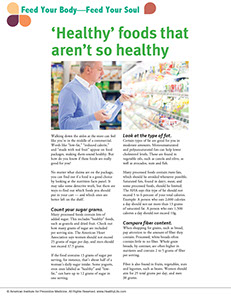SYMPTOM CHECKER
CONDITIONS
Male
Female
Child
Arm, Hand & Shoulder Concerns
Legs & Feet Concerns
Dental & Mouth Concerns
Ear & Nose
Eye Conditions
Head Conditions
Arm, Hand & Shoulder Concerns
Legs & Feet Concerns
Front
Back
Arm, Hand & Shoulder Concerns
Dental & Mouth Concerns
Ear & Nose
Eye Conditions
Head Conditions
Arm, Hand & Shoulder Concerns
Dental & Mouth Concerns
Ear & Nose
Eye Conditions
Head Conditions
Front
Back
Arm, Hand & Shoulder Concerns
Neck Links
Head & Neck Concerns
Arm, Hand & Shoulder Concerns
Neck Links
Head & Neck Concerns
Front
Back
Online Clinic
Wise Healthcare
‘Healthy’ foods that aren’t so healthy
Print on Demand
Walking down the aisles at the store can feel like you’re in the middle of a commercial. Words like “low-fat,” “reduced calorie,” and “made with real fruit” appear on food packages, making them sound healthy. But how do you know if these foods are really good for you?
No matter what claims are on the package, you can find out if a food is a good choice by looking at the nutrition facts panel. It may take some detective work, but there are ways to find out which foods you should put in your cart — and which ones are better left on the shelf.
Count your sugar grams.
Many processed foods contain lots of added sugar. This includes “healthy” foods, such as granola and dried fruit. Check out how many grams of sugar are included per serving size. The American Heart Association says women should not exceed 25 grams of sugar per day, and men should not exceed 37.5 grams.
If the food contains 13 grams of sugar per serving, for instance, that’s about half of a woman’s daily sugar intake. Some yogurts, even ones labeled as “healthy” and “low-fat,” can have up to 12 grams of sugar in one serving.
Look at the type of fat.
Certain types of fat are good for you in moderate amounts. Monounsaturated and polyunsaturated fats can help lower cholesterol levels. These are found in vegetable oils, such as canola and olive, as well as avocados, nuts and fish.
Many processed foods contain trans fats, which should be avoided whenever possible. Saturated fats, found in dairy, meat, and some processed foods, should be limited. The AHA says this type of fat should not exceed 5 to 6 percent of your total calories. Example: A person who eats 2,000 calories a day should not eat more than 13 grams of saturated fat. A person who eats 1,500 calories a day should not exceed 10g.
Compare fiber content.
When shopping for grains, such as bread, pay attention to the amount of fiber they contain. Processed, white breads often contain little to no fiber. Whole grain breads, by contrast, are often higher in nutrients and contain 2 to 5 grams of fiber per serving.
Fiber is also found in fruits, vegetables, nuts and legumes, such as beans. Women should aim for 25 total grams per day, and men 38 grams.
This website is not meant to substitute for expert medical advice or treatment. Follow your doctor’s or health care provider’s advice if it differs from what is given in this guide.
The American Institute for Preventive Medicine (AIPM) is not responsible for the availability or content of external sites, nor does AIPM endorse them. Also, it is the responsibility of the user to examine the copyright and licensing restrictions of external pages and to secure all necessary permission.
The content on this website is proprietary. You may not modify, copy, reproduce, republish, upload, post, transmit, or distribute, in any manner, the material on the website without the written permission of AIPM.
2021 © American Institute for Preventive Medicine - All Rights Reserved. Disclaimer | www.HealthyLife.com

















































